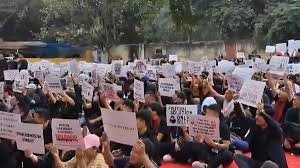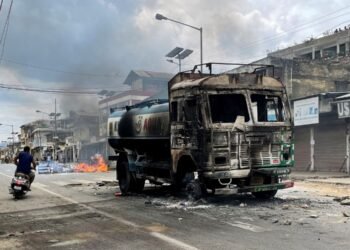As Assembly elections near, eviction drives and anti-immigrant rhetoric in Assam have triggered concerns of orchestrated communal polarisation across the Northeast. Critics accuse BJP-led governments of stoking fear and division to gain electoral ground.
By PC Bureau
July 29, 2025 —Ahead of the next year’s Assam Assembly elections approaching, political observers and rights groups are sounding the alarm over a rising wave of communal polarisation sweeping across the Northeast. At the heart of this political shift is Assam Chief Minister Himanta Biswa Sarma, whose administration has intensified eviction drives under the banner of targeting “illegal immigrants.” But the rhetoric is no longer confined to Assam — it is rapidly influencing policy in neighbouring states like Nagaland, Manipur, and Meghalaya.
Critics argue that the so-called “Assam model” is being adopted by BJP-led or BJP-allied governments across the region, using unverified claims of mass infiltration to paint entire communities — often Bengali-speaking Muslims or marginalised borderland tribes — as outsiders. The objective, they allege, is not law enforcement but electoral gain through fear and division.
On Monday, the Congress party launched a scathing attack on the eviction operations in Assam. Senior Congress leader Ripun Bora accused the BJP government of exploiting the issue to deepen communal divides ahead of the polls.
READ: Exclusive: SIR Amid Ruins— Bihar’s SIR Redux in Manipur
“These eviction drives are not about illegal encroachments. They’re about dividing Hindus and Muslims for votes,” Bora told reporters. “If the government is genuinely targeting illegal Bangladeshi nationals, then why offer Rs 50,000 in compensation to the evictees?”
He questioned the timing of the actions: “The BJP has ruled Assam for nearly a decade. Why are these mass evictions happening only now, just months before the election?”
🚨 ASSAM’S BIGGEST EVICTION DRIVE UNDERWAY! 🚜🔥
CM Dr @himantabiswa unleashes a massive operation in Rengma Forest, Uriamghat targeting illegal encroachment by Bangladeshi-origin Muslims:
⚠️ 11,000+ acres of forest land grabbed
⚠️ Illegal mosques, madrasas & schools… pic.twitter.com/OCHM1qbMMD— Oxomiya Jiyori 🇮🇳 (@SouleFacts) July 29, 2025
Bora also dismissed the official narrative as a smokescreen to hide the state government’s failure to address pressing developmental challenges. “This government has exhausted every trick in the book — money power, muscle power, and the misuse of administrative machinery. Now, with nothing left, they are turning to the politics of fear and hatred.”
As other states begin issuing orders to “monitor influx” and restrict settlement by people from neighbouring regions — often without credible evidence — opposition leaders warn that a dangerous pattern is taking hold. The Congress has called it a calculated communal agenda by the BJP to consolidate power across the Northeast.
The Eviction Template
In Assam, Sarma’s government has carried out repeated eviction drives in districts like Barpeta, Dhubri, Hojai and Goalpara — often accompanied by bulldozers and heavy police presence. The rationale? Clearing “encroached” land from “illegal immigrants” — a label widely understood as targeting Bengali Muslims, many of whom have lived in the state for generations.
READ: No Arrests, No Names: The Curious Case of Manipur’s Mysterious Arms Recovery
This language has now made its way into government orders in other northeastern states. Nagaland’s Home Department recently issued a directive asking local authorities to identify “illegal migrants” and halt any new settlements. In Manipur, similar rhetoric has been used to justify surveillance, fencing projects and now, a controversial Special Summary Revision (SIR) of voter rolls — even as thousands of citizens displaced by last year’s ethnic violence remain without documents or shelter.

Observers say these moves are not isolated but part of a larger pattern — one designed to consolidate votes around ethnic and religious fault lines. “This imaginary influx narrative is being weaponised to turn the people of the Northeast against each other,” says a senior Congress leader from Assam. “It’s not about governance; it’s about deepening divisions ahead of elections.”
In Manipur, where the Meitei-Kuki conflict has displaced over 60,000 people, the push to revise electoral rolls has sparked outrage. Activists say the drive, modelled after Bihar’s Special Intensive Revision (SIR), could erase thousands of legitimate voters — many from tribal communities — who lost their homes and papers in the violence. The Congress has called the exercise “a communal agenda cloaked as administrative duty.”
BJP’s Polarisation Playbook?
The Bharatiya Janata Party (BJP) has long capitalised on identity-based mobilization — and the Northeast is no exception. Sarma, the region’s most high-profile BJP face, has repeatedly framed demographic changes as an existential threat to “indigenous culture.” His recent comments on “preserving Assamese identity” and “removing illegal settlers” have been echoed by regional allies and right-wing groups, from Nagaland to Tripura.
Yet critics point out the contradictions. “If illegal influx was truly the issue, the government would act on actual data. Instead, we see vague circulars, no transparency, and no legal recourse,” says Pranab Saikia, a Guwahati-based political analyst. “It’s a fear campaign — and it’s working.”
The Congress and other opposition parties have condemned the polarising rhetoric and warned of the long-term damage it could cause to the social fabric of the Northeast. “These are multi-ethnic, multi-faith states. Any attempt to communalise their politics is dangerous,” said Jairam Ramesh, Congress General Secretary.
On the ground, the fear is palpable. In eviction-hit districts, families who once relied on land for survival now live in limbo — without resettlement plans or rehabilitation. In conflict zones like Manipur, survivors fear disenfranchisement just as much as displacement.
As polls approach, the political machinery appears set to turn these insecurities into electoral capital.













